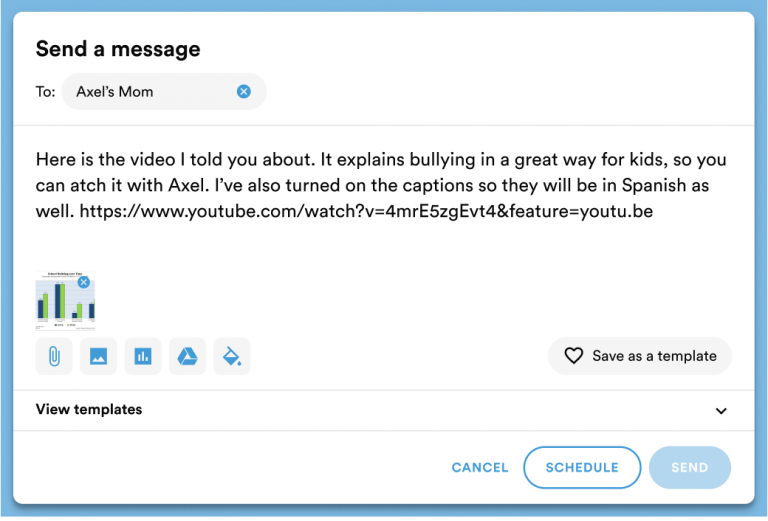Using TalkingPoints to Connect, Model and Promote Awareness
With grades due and the holidays fast approaching, it’s easy to understand why educators and families are so busy this time of year–especially when you consider the added challenges of distance and hybrid learning.
But no matter what new difficulties we face in helping our students this season, we can’t lose sight of an issue that affects many of them the whole year through–whether they’re learning in a classroom or on a computer. Bullying.
Bullying is hardly a new topic. But how can we really address it? Can we go beyond simply bringing attention to the problem and really try to do something about it? TalkingPoints thinks so. Below, we’ll explain how, by starting with an overview of the problem–and ending with some clear, direct actions that educators and families can take to stop it.
Bullying: What is it and who is affected?
Dan Olweus, Pd.D, founder of the Olweus Bullying Prevention Program defines bullying as “when someone repeatedly and on purpose says or does mean or hurtful things to another person who has a hard time defending himself or herself.”
In the scenario evoked by the definition, there are several individuals involved. There is a bully. There is a victim. And there are numerous others witnessing the bullying taking place. These are all individuals who, if they were more knowledgeable about what was happening and how to stop it, might take action. Do we have the power to change that scenario?

Studies have shown the average rate of bullying involvement, whether actively engaged or being victimized, for children ages 12-18 is at 36% (Modecki et al. 2014).That figure does not include the children witnessing the bullying, although they may also be impacted by the experience. With all these children being influenced by the issue of bullying, what do we do?
We believe that building strong connections between school and home is crucial to student success. This extends to the idea of creating positive environments that bring awareness to bullying and responses to it at home.
What is the solution?
Family engagement.
Numerous studies have shown that parent involvement in school-wide bullying-prevention programs is a critical way to bring bullying to an end.. Joyce L. Epstein, Ph.D. in sociology and Professor of Education at Johns Hopkins University, presents the project of school improvement as an effort involving three parties: the school, the community and the families. (cite)
A study in the Journal of Child and Family Studies in October of 2017 surveyed over 1400 parents and guardians of children in grades 2, 4 and 6 participating in one such program to monitor their perceived influence on their children’s bullying behavior and responses to being bullied. The study found that involving families in school-wide bullying prevention programs is critical to the success of the program (Lester et al. 2017).
Simply by engaging in meaningful conversations at home about the prevention of and effects of bullying, families reported seeing a difference in their children’s responses to it. These discussion and community elements, though seemingly simple, have a ripple effect on a child’s development and learning.

It’s that simple. Involving families in their children’s education—including socially and emotionally—is paramount to their success.
How does TalkingPoints fit in?
TalkingPoints is more than a messaging app—it’s a relationship-building tool that parents and teachers can leverage in the fight against forces like bullying. But how can such a simple app do that?
Connect and build relationships between school and home
Bullying and a child’s response to it is highly influenced by the adults in their lives. One of the most important things a teacher can do to advocate for a child’s emotional wellbeing is bringtheir family members into the classroom. Regardless of a parent’s previous engagement with formal education or the school system, they are the expert on their child, and should always be welcomed on their child’s educational journey.
Teachers can make sure to involve families by checking in with them regularly. Over time, this leads to strong and lasting relationships between school and home. It also helps the child see, “There’s a whole community of adults rooting for me!”
Send simple, direct messages asking families how things are going at home or thanking them for staying involved. A little connection goes a long way.

Promote trust, share information, and raise awareness
Strong connections equal trust. Teachers have influence and so do parents. When they are working in tandem to support a child, they can do incredible things.
Using TalkingPoints to share ideas, resources and other types of support is a great way to promote a child’s wellbeing. This includes sharing information about bullying-prevention programs.
In your TalkingPoints for Teachers account, you can paste links to videos of inspiring messages (learn how to turn on the captioning/translation here), attach photos of bullying data and recommendations for further research into your favorite research-based prevention programs.

Model how to have difficult conversations
Children mimic what they see adults doing, whether we like it or not. That’s why it’s important not to avoid difficult conversations between home and school, but to have them, especially when a child’s wellbeing is at stake. That’s also why it’s important to have these difficult conversations with a mutual sense of trust, respect and understanding between all parties involved.
If the hard work has been done to build strong relationships, they won’t be quite so difficult. We trust each other. We have a mutual understanding of our goals. Let’s talk.
The doors are now open to have deeper conversations, whether initiated by the teacher or parent, about an individual child’s experience with bullying. Are they hurting others? Are they being hurt?
Modeling an open and honest conversation about a difficult topic without anger, even through text, is a great way to use TalkingPoints in the prevention process.

To find additional resources on Bullying research, prevention and resources, click here.
Ready to get started? Log into your TalkingPoints account and send a message now.
Login to TalkingPoints for Teachers
Learn about TalkingPoints for Parents
Citations
- “Definition.” Olweus Bullying Prevention Program, Clemson University, olweus.sites.clemson.edu/bullyinginfo.php.
- Epstein, J. L., Sanders, M. G., Simon, B. S., Salinas, K. C., Jansorn, N. R., & Van Voorhis, F. L. (2002). School, family, and community partnerships: Your handbook for action (2nd ed.). Thousand Oaks, CA: Corwin Press.
- Lester, Leanne & Pearce, Natasha & Waters, Stacey & Barnes, Amy & Beatty, Shelley & Cross, Donna. (2017). Family Involvement in a Whole-School Bullying Intervention: Mothers’ and Fathers’ Communication and Influence with Children. Journal of Child and Family Studies. 26. 1-12. 10.1007/s10826-017-0793-6.
- Modecki, K. L., Minchin, J., Harbaugh, A. G., Guerra, N. G., & Runions, K. C. (2014). Bullying prevalence across contexts: A meta-analysis measuring cyber and traditional bullying. Journal of Adolescent Health, 55, 602–611. doi:10.1016/j.jadohealth. 2014.06.007.



